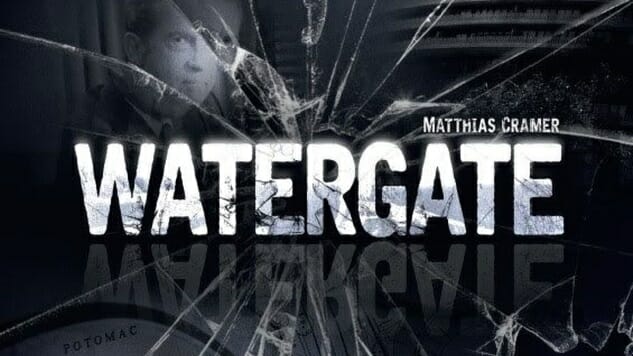
The President is besieged by reports of a scandal, and intrepid reporters are trying to uncover the details and get more members of his Administration to turn on him—perhaps enough to force him to resign. I’m talking about President Nixon and the efforts of the Washington Post in 1972-74, of course, but the spectacular new two-player game Watergate couldn’t have come out at a better time.
Designer Matthias Cramer, whose first title Glen More is an overlooked classic worker placement game, has managed to do something novel with hand management games by creating two decks that incorporate real people and events from the third-rate burglary attempt—a quote that Cramer uses as a card title—where each card also has two distinct uses. The cards have actual photos of the various witness and other events from the scandal, while the rulebook has an extensive appendix explaining the history and the specific roles the various people who appear in the game played in the break-in, the cover-up, and the eventual downfall of the President.
One player plays as Nixon, while the other plays the journalists, with each player playing with a unique deck, slightly distinct mechanics, and different victory conditions. (My daughter wanted to play as “the bad guy,” so she’s clearly aware of what’s going on in the world right now.) The board itself has seven major figures from the scandal around its perimeter and a photo of Tricky Dick himself in the center, with a web of spokes through spaces for evidence tokens. If the player playing as the journalists can create paths of face-up evidence tokens connecting any two witnesses to Nixon, they win the game; the player playing as Nixon will try to place evidence tokens face-down to block those routes.
The game’s turns involve a card-based fight for control of three evidence tokens drawn at random from the bag, a ‘momentum token’ handed out at the end of each turn, and the initiative token that determines the start player and gives that player one more card in the next turn. The research track has 11 spaces, five toward each player and the 0 space in the middle where all tokens (usually) begin. Every card in both players’ decks has a token movement function, showing a specific color of evidence token (green, blue, or yellow, with some wild cards as well) and a number of spaces that the token would move in that players’ direction. If you move a token all the way to your 5 spot, you simply get it; otherwise, when both players have played all of their cards, the round ends and each player gets the tokens on their side of the 0 space. The journalist places their evidence tokens face-up on the board; Nixon places their evidence tokens face-down, both only placing the tokens on spaces of the matching color. You can use your cards to move the momentum or initiative tokens instead of the evidence tokens.
The momentum tokens work differently for each player. If Nixon collects five of the momentum tokens, then he has completed his second term in office and that player wins the game automatically. The journalist gets nothing for the first two momentum tokens they gain, but the next three add substantial one-time bonuses, like removing a face-down evidence token from the board.
The cards in players’ decks also have a second function beyond just moving a token, and most of the time those functions are single-use, after which you remove the card from the game. Each player has seven cards matching the identities of the seven witnesses; the journalists are trying to recruit those witnesses, while Nixon is trying to secure them as allies, in which case they can’t be connected to Nixon on the board. There are limited chances for the journalist player to turn a witness to their side, but once they’ve claimed a witness the Nixon player can’t turn that token back. Nearly all of your cards, regardless of your side, have that one-time function, which can also amount to blocking an opponent’s move, moving three separate tokens in one turn, or taking a token from your opponent’s side of the track and putting it back in the bag.
Your deck is small no matter your side, and you’ll go through it probably twice over the course of a game, maybe getting into a third shuffle, so trashing cards to use their one-time function is a significant choice, and many of those cards also have very powerful token-moving abilities that you forego when you choose to use their text function. The individual choices you’ll make involve some light strategy but the core decision in the game is how aggressive to be in using those card powers to recruit witnesses or grab control of a token or two.
The theme itself is really well explained and depicted, although the integration with the game’s mechanics is a bit thin; it’s not as if the powers on the cards have any real relationship to the various personages or events the game cards. It’s a great two-player asymmetric game, and the supporting text is also very well done, but those two things are just not that well blended. I’m nitpicking, and it’s still one of the best new purely two-player games I’ve played in a while, with the advantage of being extremely timely as well.
For photos of Watergate, check out its page at BoardGameGeek.com.
Keith Law is a senior baseball writer for ESPN.com and an analyst on ESPN’s Baseball Tonight. You can read his baseball content at search.espn.go.com/keith-law and his personal blog the dish, covering games, literature, and more, at meadowparty.com/blog.